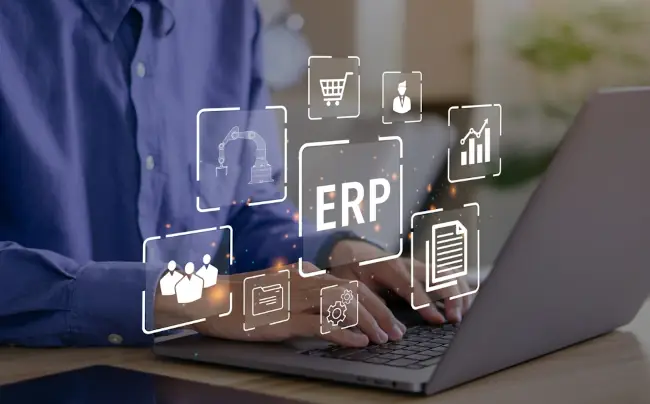What is ERP? Enterprise Resource Planning Guide
Businesses that want to gain a competitive advantage in today’s business world have to manage their processes more efficiently, quickly and in an integrated manner. This is where ERP (Enterprise Resource Planning) comes into play! If you are asking the question “What is ERP?” or wondering how to use this system for your business, you are in the right place. In this guide, we will take a detailed look at what ERP systems are, how they work, the benefits they provide and how they can add value to your business. Whether you are a small business owner or a manager of a large enterprise, get ready to discover how ERP can help you!

What is Enterprise Resource Planning (ERP)?
ERP stands for Enterprise Resource Planning . It is software that combines processes in different departments of businesses (accounting, human resources, production, inventory management, customer relations, etc.) on a single integrated platform. This system collects all processes in a centralized database and provides real-time information flow between departments.
What does this mean? For example, if you have a manufacturing company, an order received by your sales team is instantly reflected in inventory management, production and accounting. Manual data entry is eliminated, errors are reduced and time is saved. Enterprise Resource Planning is like the glue that binds all the pieces of your business together.
Key Features of the System
Integration: Unifies different departments.
Automation: Automates repetitive tasks.
Real Time Data: Provides instant reporting and analysis.
Flexibility: It can be customized according to the needs of your business.
Advantages of Enterprise Resource Planning Systems
The benefits of these systems are not limited to time and cost savings. Here are the most important advantages:
1. Increased Productivity
Enterprise Resource Planning accelerates workflows by eliminating manual processes. For example, processes such as invoicing or inventory tracking become automated. Employees can focus on strategic tasks instead of routine ones.
2. Better Decision Making
They provide real-time data and comprehensive reporting tools. Managers can make more informed and faster decisions. For example, the availability of a product or the performance of a campaign can be analyzed instantly.
3. Collaboration between Departments
The system removes communication barriers between departments. Sales, production and logistics teams can access the same data, increasing coordination and reducing errors.
4. Cost Reduction
Reduces unnecessary expenditure by optimizing processes. For example, problems such as overstocking or wrong orders are avoided. Also, the need to use multiple software is eliminated.
5. Scalability
As your business grows, the system grows with you. You can add new modules or expand existing features.
How do Enterprise Resource Planning Systems Work?
These systems consist of a series of modules and each module manages a specific business process. The modules are linked to a central database. Here is how it works:
Data Collection: Data (e.g. sales figures, inventory levels) is collected from different departments of the business.
Integration: Data is stored in a database that all modules can access.
Automation: Processes are automated (for example, an invoice is automatically generated when an order is received).
Reporting: Meaningful reports are generated from the collected data.
For example, when a customer places an order, the system receives the order from the sales module, notifies the inventory module, updates the production planning and prepares the invoice in the accounting module. All this happens in a matter of seconds.
Popular Modules
Finance and Accounting: Budget management, invoicing, financial reporting.
Human Resources: Payroll, recruitment, performance management.
Inventory and Supply Chain: Inventory tracking, logistics, supplier management.
Production: Production planning, quality control.
CRM (Customer Relationship Management): Customer data, sales tracking.
Who Should Use Enterprise Resource Planning?
These systems are suitable for businesses of all sizes, but are especially critical for
Growing Businesses: As processes become more complex, manual management becomes insufficient.
Multi-Department Companies: When data sharing between departments is required.
Those who want to make data-driven decisions: For real-time analysis and reporting.
International Operations: For consistent process management across locations.
For small businesses, cloud-based solutions offer a low-cost and easy-to-implement option. Large enterprises, on the other hand, often prefer customized, on-premises systems.
What to Consider When Choosing Enterprise Resource Planning?
Choosing the right system is a critical decision for the success of your business. Here are the points you should pay attention to:
1. Business Needs
Assess whether the system meets the specific needs of your business. For example, if you are a manufacturing company, you should choose a solution with a powerful production module.
2. Ease of Use
A complex system can make it difficult for your employees to adapt. Opt for a user-friendly interface.
3. Cost
The cost of systems includes license fees, implementation costs and maintenance expenses. Choose a solution that fits your budget.
4. Cloud or On-Premises?
Cloud-based solutions are more flexible and cost-effective, but if you are concerned about data security, consider on-premises systems.
5. Support and Updates
Technical support and regular updates from the provider are important for the long-term success of the system.
The Future of Enterprise Resource Planning
These systems are constantly evolving as technology advances. Technologies such as artificial intelligence, machine learning and IoT (Internet of Things ) are increasing capabilities. For example:
AI Based Analytics: More accurate demand forecasting and risk analysis.
IoT Integration: Real-time data collection from production equipment.
Mobile Solutions: Administrators can access systems from anywhere.
Moreover, the proliferation of cloud-based solutions makes these systems more accessible and cost-effective. In the future, more flexible, intelligent and user-friendly systems are expected.
Conclusion
Enterprise Resource Planning is a powerful tool that optimizes business processes, increases efficiency and provides a competitive advantage. The right system can help your business grow and take you into the future. If you are tired of managing processes manually or need data to make better decisions, it is time to give these solutions a chance!
Analyze your needs, compare different solutions and get support from an expert consultant to find out which system is right for you. We wish you success on your journey!


